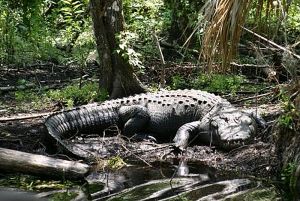| Tropical Fish | Marine Fish | Pet Birds | Dogs | Cats |
| Reptiles | Amphibians | Small Pets | Insects & Spiders | Wildlife |
Florida Alligator Habitat
 By: Johan
By: Johan 

Typical examples of typical Florida alligator habitat are fresh or slightly brackish environments in warm regions of the south-east United States. Florida alligators live in coastal marshes, swamps, ponds, lakes, rivers and man made canals. A Florida alligator habitat will always include some form of water source, since the Florida alligator needs water to regulate its body temperature, feed, reproduce and create a social organization.
There must also be a piece of land where the Florida alligator can bask in the sun and seek shade among vegetation. Controlling its body temperature by moving from warm spots to cooler spots is very important for the Florida Alligator, since its body does not regulate temperature in the same way as mammal bodies do.
Alligators have inhabited wetlands since the Mesozoic Era over 200 million years ago, in this is probably one of the reasons why they survived when so many other reptile species died out. A wetland is a transitional environment situated between a terrestrial and an aquatic ecosystem.
Florida alligator habitat – where?
The Florida Alligator is not only found in Florida, it is found in suitable Florida alligator habitats throughout the U.S. South-East. The Florida alligator habitat range stretches from Merchants Millpond State Park in North Carolina, west to eastern Texas, northwards toward south-east Oklahoma, and south to the Florida Keys.
Florida Alligator habitat – impact
The Florida Alligator is highly important for the entire Florida Alligator habitat. It is an apex predator that affects the entire food chain by controlling the population of smaller animals that might otherwise overpopulate the habitat.
The Florida Alligator is also responsible for creating so called “gator holes”. The alligator will use its mouth and claws to clear out a gator hole by uprooting vegetation. As the gator hole grows, the alligator will enlarge it further by shoving with its body and wipe its powerful tail from side to side. Eventually, the alligator will have created a depression that will become filled with water during the rainy season. These gator holes are extremely important for the entire Florida Alligator habitat, since they will hold water well into the dry season. During droughts, the gator hole can be the only way for fish, crustaceans and turtles to survive. Insects, snakes, birds and other animals will also frequently flock around gator holes since they provide a valuable source of water. The gator hole is naturally also very important for the gator itself.
Florida Alligators can use the same gator hole for many years and gradually expand it over time. Florida Alligators are also known to sometimes expand their holes by excavating an overhanging bank. Tunnels stretching as far as 20 feet (6 metres) have been found in Florida alligator habitats. At the end of the tunnel, the alligator will dig out a chamber. It is important that the ceiling is high, since a high ceiling makes it possible for the alligator to breath inside the water filled chamber. This form of alligator holes makes it easier for the animal to survive winters and droughts in the Florida Alligator habitat.
Alligator Articles:
Florida Alligator
Florida Alligator Facts
Florida Alligator Hunting
